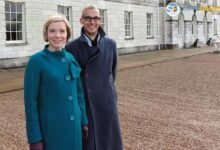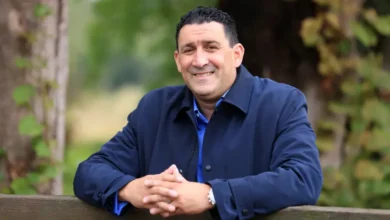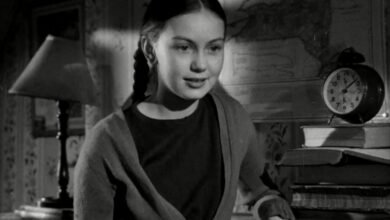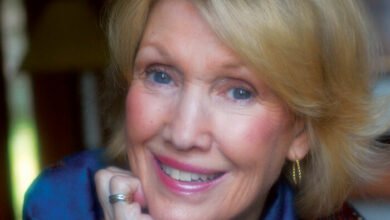David Dickinson: From Trading Stalls to Television Stardom
When people hear the name David Dickinson, they instantly picture his glowing tan, flamboyant suits, and sparkling charisma. Known affectionately as “The Duke,” he’s one of Britain’s most recognizable television personalities. But beyond his famous catchphrases and warm humor lies a story of grit, redemption, and relentless self-belief.
This article dives into the life of David Dickinson — tracing his journey from humble beginnings and personal challenges to his iconic status on British television. It’s a tale of how authenticity and perseverance can turn even the most unlikely paths into lifelong success.
Early Life and Family Roots
David Dickinson was born on August 16, 1941, in Cheadle Heath, Stockport, England. His birth name was David Gulesserian, and he came from Armenian heritage through his biological mother, Eugenie Gulesserian. However, he was adopted as a baby by Jim and Joyce Dickinson, who gave him their family name and raised him as their own.
Growing up in Manchester, David’s childhood was modest yet loving. He was primarily raised by his grandmother and aunt, who instilled in him the values of hard work and self-reliance. Discovering at age twelve that he was adopted was a defining moment — one that shaped his understanding of identity and belonging.
Although he found stability in his adoptive family, the knowledge of his Armenian roots always lingered in his mind. It wasn’t until later in life that he fully embraced both sides of his background, seeing it as a source of pride and individuality.
Youthful Mistakes and Turning Points
David left school at fourteen and began working as an apprentice in an aircraft factory. However, he soon discovered that his true passion lay in trading and business. His natural charm and sharp eye for deals made him well-suited to the world of buying and selling textiles in Manchester’s bustling markets.
Yet, not all early ventures went smoothly. At just nineteen, David made a serious mistake — becoming involved in a mail-order fraud scheme. He was sentenced to four years in prison and served three. It was a harsh lesson that could have broken him, but instead, it became a turning point.
During his time in prison, David reflected deeply on his choices and vowed never to walk that path again. When he was released, he rebuilt his life from scratch, returning to honest trading. That moment of redemption would become one of the cornerstones of his later public persona — a man who had fallen but found his way back stronger than ever.
Discovering the World of Antiques
After his release, David began dealing in antiques — a move that would define the rest of his career. He had a keen eye for craftsmanship, design, and historical value, often traveling across the UK to attend auctions and fairs. His small antique business gradually gained attention, especially for his ability to spot underappreciated treasures.
By the 1980s, he had established himself as a respected antiques dealer, specializing in 18th- and 19th-century furniture. However, the economic recession of the early 1990s forced him to close his store. Instead of giving up, he reinvented himself once more, becoming a private dealer and consultant.
This stage of his life also prepared him for something he hadn’t expected — a career in front of the camera.
The Rise of David Dickinson on Television
It was pure chance that brought David Dickinson into the spotlight. In the late 1990s, a television producer noticed his charisma at an antiques fair and invited him to appear in a documentary. His personality and encyclopedic knowledge of antiques made an immediate impression.
That first appearance opened the door to new opportunities, and before long, David was invited to join the BBC series The Antiques Show. Audiences were instantly drawn to his lively energy and natural flair for entertainment. But his true breakthrough came in 2000 when he became the host of Bargain Hunt.
The show paired amateur antique hunters with experts who competed to make profits at auctions. David’s witty remarks, enthusiastic delivery, and genuine passion for the trade turned the program into a daytime phenomenon. His catchphrases — “a real bobby-dazzler” and “cheap as chips” — became part of British pop culture.
Reinvention and Dickinson’s Real Deal
After four successful years with the BBC, David made the bold move to ITV, where he launched Dickinson’s Real Deal in 2006. The format gave members of the public the chance to sell antiques and collectibles directly to dealers or take their chances at auction.
David’s role was part host, part mentor, part showman — guiding participants, offering advice, and injecting humor into every episode. His distinctive tan, elegant suits, and flamboyant personality made him instantly recognizable. Audiences loved him not just for his knowledge but for his warmth and sincerity.
Under his guidance, Dickinson’s Real Deal became one of ITV’s longest-running daytime shows, cementing his reputation as a television icon.
The Man Behind the Persona
While his on-screen energy and confidence make him larger than life, David Dickinson’s private life paints a picture of humility and loyalty. He has been married to his wife, Lorne Lesley, since 1968. Lorne, a former cabaret performer, shares his zest for life and creativity.
The couple have two children and several grandchildren, and they live quietly in Cheshire, away from the glare of the spotlight. David often credits his wife as his biggest supporter and grounding force throughout the ups and downs of fame.
Despite his celebrity, David remains a family man who enjoys simple pleasures — spending time with loved ones, dining out, and occasionally revisiting antique fairs just for the thrill of the find.
The Legacy of David Dickinson
The legacy of David Dickinson extends beyond television. He revolutionized how people think about antiques — making the world of collecting accessible, fun, and full of personality. Before his arrival, antiques programming was often perceived as elitist or reserved for experts. He broke that barrier, proving that anyone could appreciate craftsmanship and history.
Through his shows, David inspired viewers to look differently at the objects in their own homes — to see beauty and value in what others might overlook. His approachable style turned him into not just a TV presenter, but an educator of sorts.
What Makes Him So Memorable
1. His Authenticity:
Viewers feel that what they see is what they get. David doesn’t play a role — he is that energetic, warm, and passionate person.
2. His Style:
The tan, the tailored suits, the gold jewelry — they’ve become his trademarks. But they’re not vanity; they’re expressions of confidence and self-respect.
3. His Catchphrases:
Simple phrases like “bobby-dazzler” became endearing because they reflected his genuine excitement.
4. His Journey:
Few public figures can say they’ve truly reinvented themselves after early mistakes. His redemption story inspires countless fans who believe it’s never too late to start over.
Overcoming Challenges and Misconceptions
David’s journey wasn’t without criticism. Some skeptics mocked his flamboyant fashion or his tan, while others underestimated his business acumen. But he never let public opinion define him. Instead, he turned those traits into strengths — making himself instantly recognizable and unforgettable.
His openness about his past also set him apart. Instead of hiding his youthful mistakes, he acknowledged them openly and used them as a platform to show how growth and accountability can lead to success. That honesty only deepened his connection with fans.
A Figure of Resilience and Reinvention
David Dickinson’s story is ultimately one of resilience. From a difficult start and a major setback in his youth to becoming one of Britain’s most beloved television hosts, his life proves the power of determination.
He has often said that life, like antiques, is about finding value in what others overlook. That philosophy runs through every part of his career — whether it’s spotting a hidden gem in a dusty shop or recognizing untapped potential in himself.
His charisma is genuine, his humor infectious, and his optimism unshakable. Even decades into his career, he continues to bring joy to millions with his signature enthusiasm and unwavering positivity.
Lessons from the Life of David Dickinson
The life of David Dickinson offers lessons that go far beyond the world of antiques or television.
1. Redemption is Possible.
Mistakes don’t define you. What matters is what you do afterward. David’s transformation from a troubled youth to a respected public figure shows the power of reinvention.
2. Authenticity Wins.
Audiences are drawn to honesty. His success is rooted in being unapologetically himself.
3. Passion Never Ages.
He found fame later in life, proving that it’s never too late to chase your dreams.
4. Individuality is Strength.
David’s unique look and voice made him stand out in an industry full of similar faces. Instead of conforming, he leaned into what made him different — and it became his greatest asset.
Conclusion
From the trading stalls of Manchester to national television screens, the story of David Dickinson is a celebration of perseverance, individuality, and the courage to reinvent oneself.
He took life’s setbacks and turned them into stepping stones. He brought antiques to the masses, laughter to daytime TV, and inspiration to anyone who has ever needed a second chance.
His charm, humor, and humanity have made him more than a presenter — he’s become a symbol of resilience and authenticity. In a world that often rewards perfection, David Dickinson stands out because he’s real. And that, more than any antique, is truly priceless.

